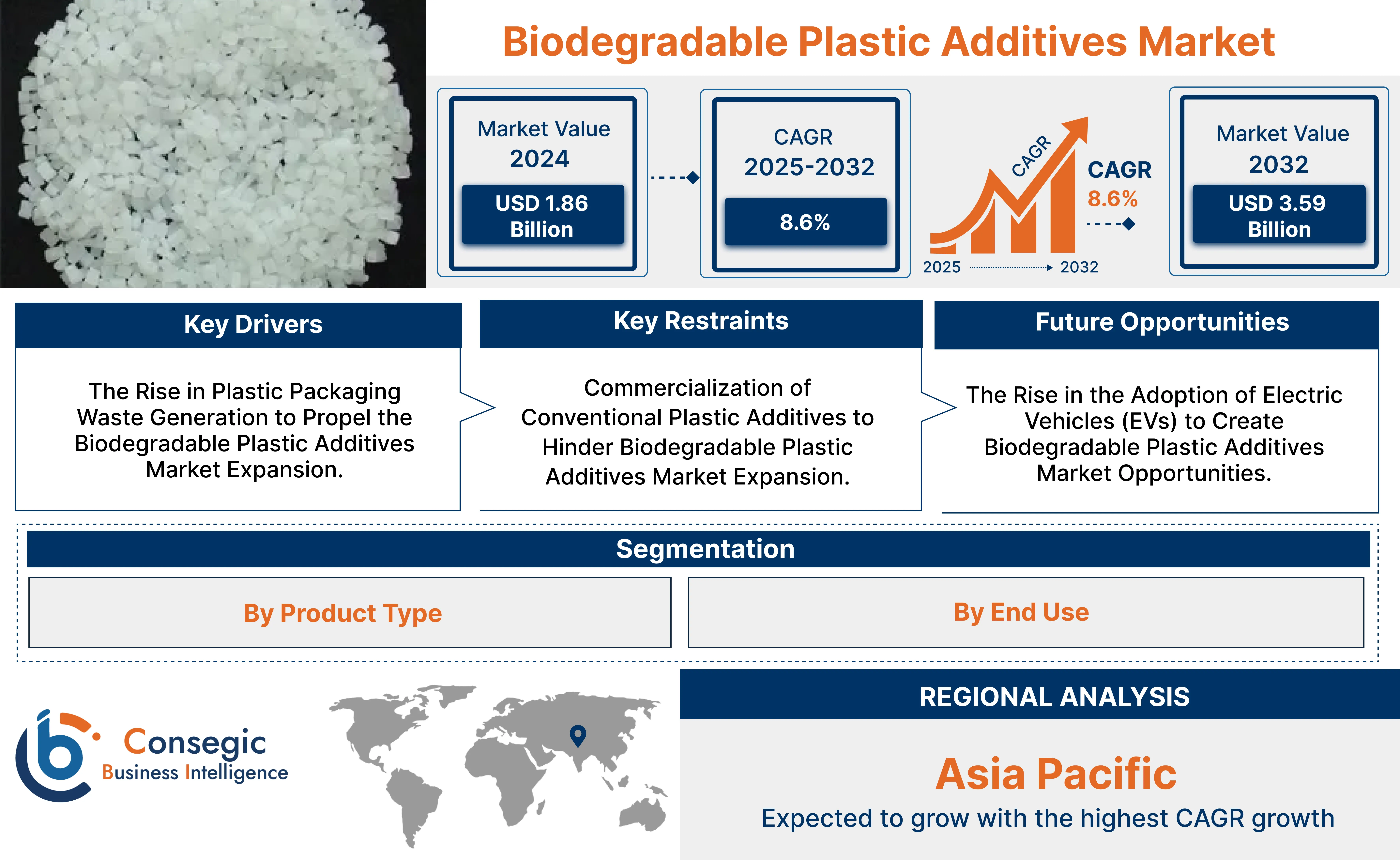Biodegradable Plastic Additives Market Size:
The Biodegradable Plastic Additives market size is growing with a CAGR of 8.6% during the forecast period (2025-2032), and the market is projected to be valued at USD 3.59 Billion by 2032 from USD 1.86 Billion in 2024. Additionally, the market value for 2025 is attributed to USD 2.01 Billion.
Biodegradable Plastic Additives Market Scope & Overview:
Biodegradable plastic additives are specialized chemical compounds that are included into conventional plastics to accelerate their degradation process when exposed to specific environmental conditions, such as the presence of microorganisms, moisture, and heat. Unlike bioplastics, which are mainly derived from renewable resources, these additives typically consist of fossil-based plastics. They generally work by attracting and stimulating the growth of naturally occurring microorganisms such as bacteria and fungi that produce enzymes, capable of breaking down the polymer chains into simpler, more natural compounds like water, carbon dioxide, and biomass. This reduces the persistent environmental burden of plastic waste in landfills and oceans, offering a partial solution to the global plastic pollution crisis.
Biodegradable Plastic Additives Market Dynamics - (DRO) :
Key Drivers:
The Rise in Plastic Packaging Waste Generation to Propel the Biodegradable Plastic Additives Market Expansion.
As awareness grows regarding the detrimental long-term environmental impact of conventional, non-degradable plastics packaging accumulating in landfills and oceans, there is a growing pressure from consumers, governments, and industries to find sustainable alternatives. Biodegradable plastic additives provide a crucial solution by allowing conventional plastics to break down more quickly and efficiently under specific environmental conditions, transforming them into substances like carbon dioxide, water, and biomass. The rise in plastic packaging waste generation is influencing the use of these additives.
For instance,
- In 2022, the data published in the Oceana report, states that Amazon's plastic packaging waste generated from all transactions in the U.S. reached 208 million pounds. This represents a 9.59% increase compared to the 190 million pounds of plastic packaging waste reported for 2021.
Thus, the rise in the generation of plastic packaging waste is propelling the biodegradable plastic additives market demand.
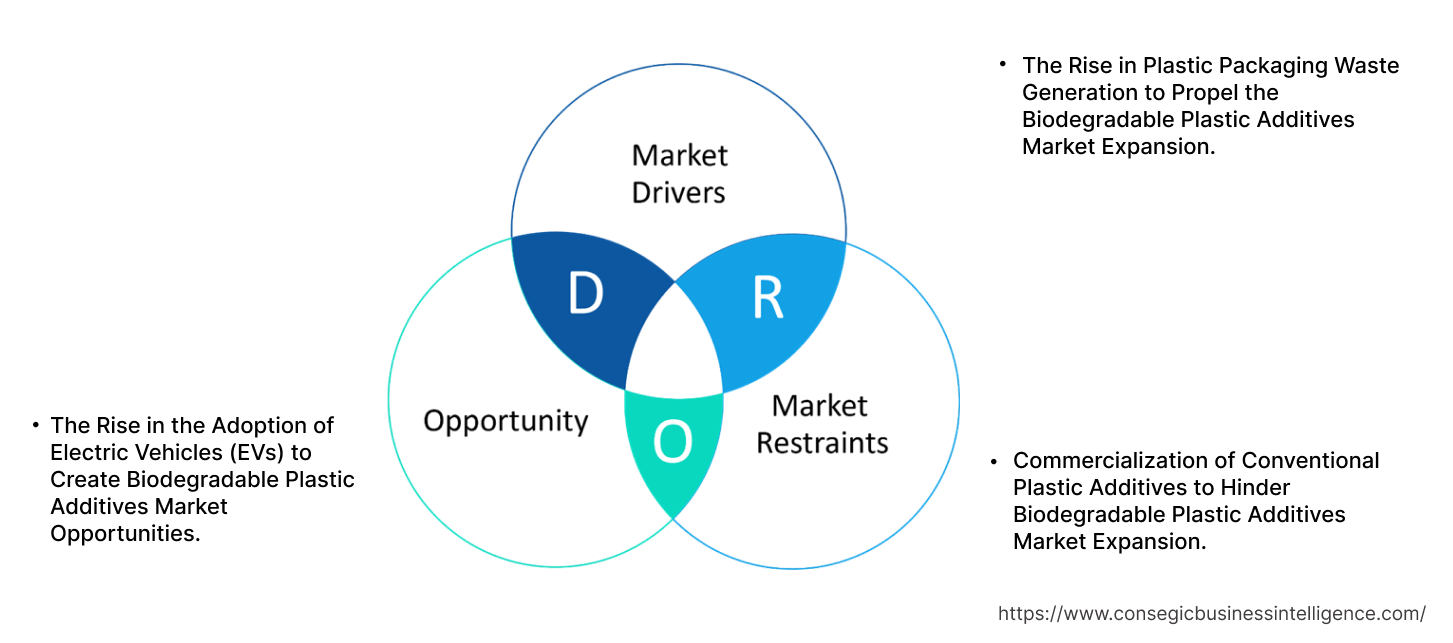
Key Restraints:
Commercialization of Conventional Plastic Additives to Hinder Biodegradable Plastic Additives Market Expansion.
Various research, development, and mass production have led to highly optimized conventional additives that offer superior performance, a wide range of functionalities, and significantly lower cost compared to their biodegradable counterparts. Manufacturers of traditional plastics have established efficient supply chains, well-understood processing parameters, and a vast array of proven formulations utilizing these conventional additives. These economic and technological formulations make it harder for biodegradable plastic additives, which mainly come with higher price points, to compete effectively and gain significant market share despite growing environmental concerns and regulatory pressures. As a result, the above-mentioned factors are limiting the biodegradable plastic additives market demand.
Future Opportunities :
The Rise in the Adoption of Electric Vehicles (EVs) to Create Biodegradable Plastic Additives Market Opportunities.
As EV production scales up, manufacturers are actively seeking lightweight, high-performance, and environmentally friendly materials to enhance battery efficiency, extend range, and improve overall vehicle sustainability. This shift away from traditional, petroleum-based plastics towards bio-based and biodegradable alternatives for interior components, structural elements, and even battery parts necessitate the use of specialized biodegradable plastic additives. The rise in the sales of electric cars is influencing the use of these additives.
For instance,
- The data by IEA states that electric car sales exceeded 17 million globally in 2024, reaching a sales share of more than 20%.
Thus, as per the market analysis, the rise in adoption of electric vehicles is influencing the biodegradable plastic additives market opportunities.
Biodegradable Plastic Additives Market Segmental Analysis :
By Product Type:
Based on product type, the market is categorized into plasticizers, stabilizers, modifiers, fillers, flame retardants, antimicrobial agents, and others.
Trends in Product Type:
- The biodegradable plastic additives market trends are influenced by innovations in plasticizer technology for enhanced material lifespan and resilience.
- The growing trend for microbial free solutions and surfaces is influencing the use of sustainable antimicrobial agents.
The plasticizer segment accounted for the largest market share of 48.91% in 2024.
- A plasticizer is defined as an additive that typically has low molecular weight and is incorporated into the polymer matrix to increase flexibility, ductility, and processability by reducing intermolecular forces between polymer chains and lowering the glass transition temperature.
- The demand for biodegradable plasticizers is surging due to stringent environmental regulations, growing consumer preference for eco-friendly products, and the expansion of biodegradable plastics into diverse applications such as food packaging, medical devices, and agricultural films.
- Manufacturers are focusing on developing novel biomass-based plasticizers for various applications.
- For instance, in 2021, BASF introduced novel biomass balanced (BMB) plasticizers based on renewable raw materials. These plasticizers have a lower carbon footprint than the conventional ones and help save fossil resources.
- Thus, as per the market analysis, the aforementioned factors are influencing the development of the segment.;
The antimicrobial agents segment is expected to grow at the fastest CAGR over the forecast period.
- Antimicrobials are specialized additives which are used in various materials during manufacturing to inhibit the growth of microorganisms such as bacteria, fungi, mold, and mildew.
- Antimicrobial agents constitute a rapidly growing segment driven by increasing consumer awareness and industry focus on hygiene and sustainability, particularly in sensitive applications like food packaging, healthcare, and consumer goods.
- These additives are incorporated into biodegradable polymers to inhibit the growth of bacteria, fungi, and molds.
- By preventing microbial colonization, they extend product shelf-life, reduce spoilage and waste, minimize the risk of contamination and illness, and enhance the overall hygiene and safety of biodegradable plastic products.
- Thus, as per the analysis, owing to the aforementioned factors, the antimicrobial agent segment is expected to grow at the fastest CAGR in the coming years.
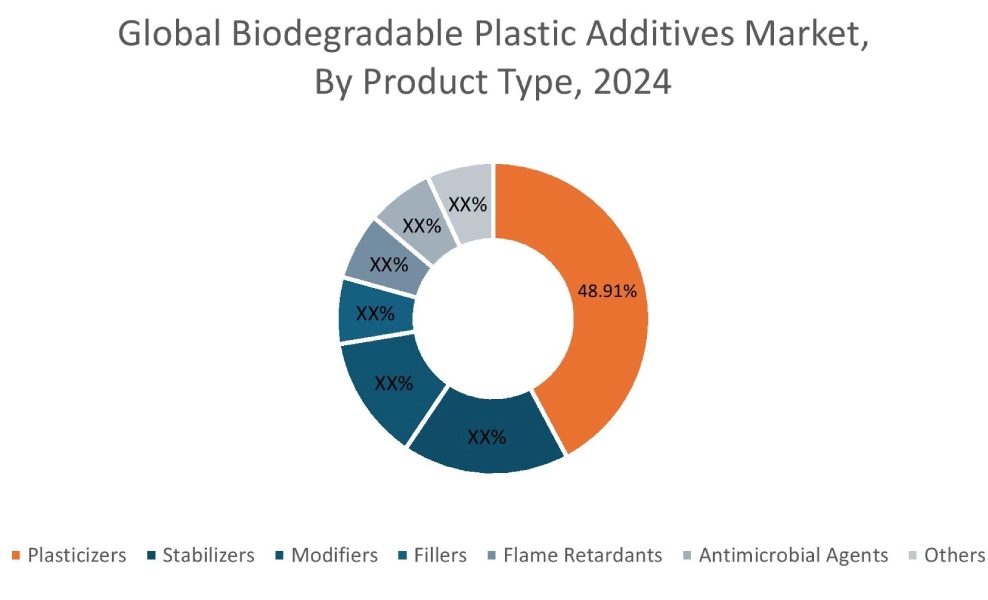
By End Use:
Based on end use, the market is categorized into packaging, consumer goods, agriculture, textiles, automotive, electrical and electronics, and others.
Trends in the End Use:
- Biodegradable plastic additives market trend is influenced by the development of novel 100% compostable plastics and the incorporation of biodegradable additives into various packaging applications.
- A significant trend in the automotive sector is rapid adoption of biodegradable plastic additives for interior components, panels, and trims to enhance sustainability, improve fuel efficiency through lightweighting, and incorporate antimicrobial properties for hygiene.
The packaging segment accounted for the largest biodegradable plastic additives market share in 2024.
- The packaging sector represents a segment driven by escalating global concerns over plastic waste and stringent environmental regulations.
- The biodegradable additives are increasingly incorporated into traditional plastics and bioplastics used for various packaging applications, including food and beverage containers, films, bags, and personal care product packaging.
- Various universities are introducing novel research hubs for developing novel compostable plastic for packaging.
- For instance, in 2024, Australia's national science agency, CSIRO, and Murdoch University have teamed up to launch the Bioplastics Innovation Hub, an USD 8 million initiative dedicated to creating the next generation of 100% compostable plastics. This collaboration aims to transform plastic packaging by developing biologically derived plastics that fully break down in various environments, including compost, land, or water.
- Thus, as per the market analysis, the rise in development of compostable plastic for packaging applications is influencing segment development.
The automotive segment is expected to grow at the fastest CAGR over the forecast period.
- The automotive sector is rapidly emerging as the fastest-growing segment in the biodegradable plastic additives market due to increasing global emphasis on sustainability, stringent environmental regulations on vehicle emissions, and consumer demand for eco-friendly products.
- Automakers are actively integrating biodegradable plastics, enhanced by specialized additives, into interior components, panels, trims, and even some under-the-hood applications, driven by the need for lightweight materials to improve fuel efficiency and the overarching goal to reduce the carbon footprint throughout a vehicle's lifecycle.
- Additionally, as car interiors are known as breeding grounds for bacteria, mold, and mildew due to frequent human contact, antimicrobial additives are being incorporated into plastic components like dashboards, door panels, seat covers, and even air conditioning systems.
- Hence, owing to the above-mentioned analysis, the automotive segment is expected to grow at the fastest rate over the future years.
Regional Analysis:
The regional segment includes North America, Europe, Asia Pacific, the Middle East and Africa, and Latin America.
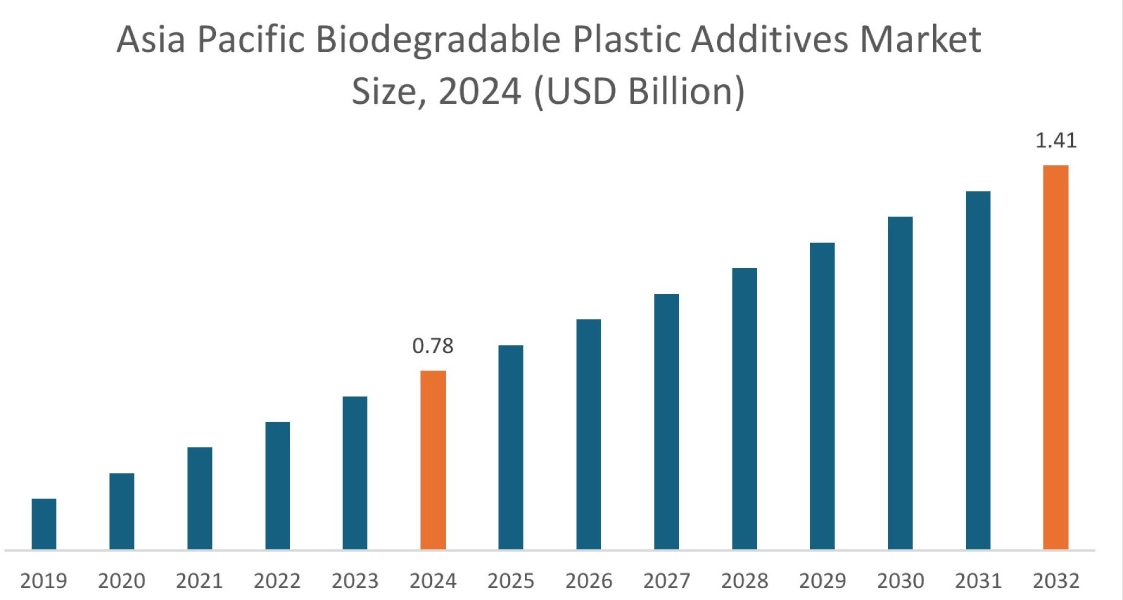
In 2024, Asia Pacific accounted for the highest biodegradable plastic additives market share at 41.98% and was valued at USD 0.78 Billion and is expected to reach USD 1.41 Billion in 2032. In Asia Pacific, China accounted for a market share of 38.60% during the base year of 2024. The Asia Pacific region is experiencing a significant surge in plastic packaging waste generation, fueled by rapid urbanization, increasing consumption patterns, a growing e-commerce sector, and a reliance on flexible and single-use plastics in industries like food and beverage. This escalating waste stream poses severe environmental challenges. The rise in the plastic waste generated because of packaging is influencing the adoption of these biodegradable additives.
For instance,
- The data by Our World in Data, in 2024, states that around 40% of the world’s plastic waste comes from packaging.;Packaging accounts for 45% of total plastic waste in China.
Thus, as per the biodegradable plastic additives market analysis, these factors create a strong upward trajectory for the Asia Pacific market, positioning it as a key region for players.
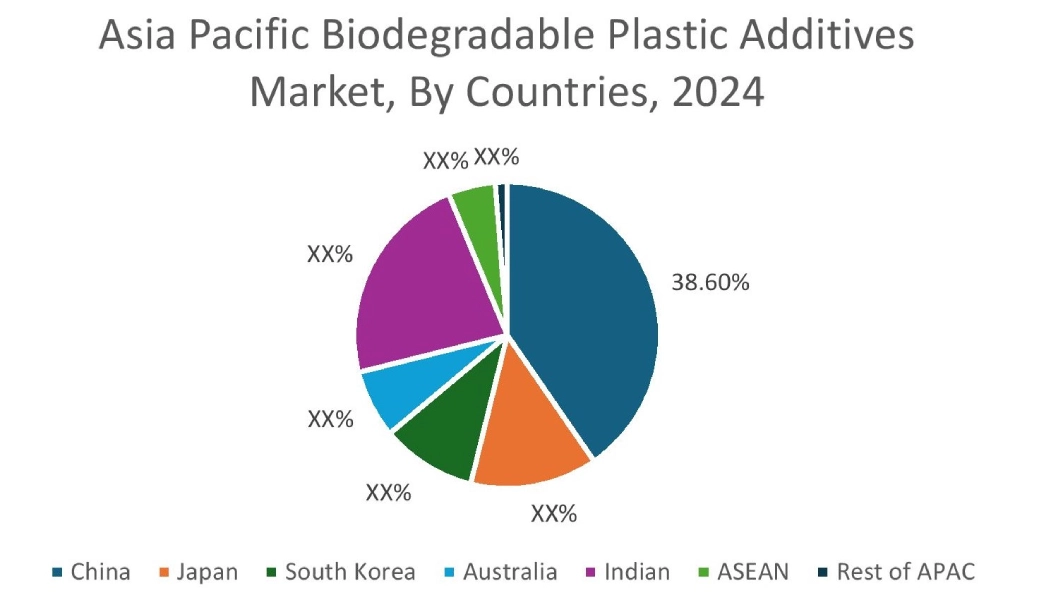
In Europe, the industry is experiencing the fastest growth with a CAGR of 10.1% over the forecast period. The increasing adoption of Electric Vehicles (EVs) in Europe is significantly influencing the demand for biodegradable plastic additives, as the automotive sector strives to meet stringent environmental regulations and consumer preferences for sustainable materials. With Europe's strong focus on circular economy principles and recycling targets for automotive plastics, there is a growing push to integrate sustainable alternatives such as biodegradable additives for plastic applications. Thus, as per the biodegradable plastic additives market analysis, the rise in electric vehicles and the use of biodegradable additives for plastic applications is driving the trends of the market in this region.
In North America, the biodegradable plastic additives industry is experiencing significant growth, with plasticizers emerging as a crucial type of additive driving this development. The region's strong industrial base, coupled with increasing environmental regulations and a rising consumer preference for eco-friendly products, is propelling the demand for biodegradable plastics. Plasticizers, specifically bio-plasticizers derived from renewable sources like vegetable oils, are vital in enhancing the flexibility, durability, and processability of biodegradable polymers such as PLA and PHA. This makes them important for a wide range of applications, including packaging materials, consumer goods, automotive components, and building & construction materials. Thus, as per the market analysis, the rise in the use of plasticizers is propelling the trends of the market in this region.
The Latin America region is increasingly using biodegradable plastic additives in consumer goods as a response to growing environmental concerns, rising consumer awareness, and evolving governmental regulations aimed at tackling plastic pollution. Countries in this region have implemented various bans on single-use plastics, driving the requirement for compostable and biodegradable alternatives across various sectors, including food service, retail, and everyday consumption. This shift is further fueled by a broader regional movement towards sustainable packaging solutions, with many Latin American nations establishing laws to reduce, prohibit, or eliminate single-use plastics. Thus, these aforementioned factors are contributing to the biodegradable plastic additives market growth in this region.
The Middle East and Africa regions are increasingly recognizing the importance of sustainable practices, leading to a growing interest in biodegradable additives within the textile sector. As the MEA region's textile and apparel market continues to expand, fueled by a growing population and rising disposable incomes, there's a growing opportunity for biodegradable additives to enhance the sustainability of fabrics, particularly in areas like technical textiles and natural fiber-based products, aligning with broader sustainability goals and promoting a circular economy. Thus, the aforementioned factors are influencing the biodegradable plastic additives market growth in this region.
Top Key Players and Market Share Insights:
The Global Biodegradable Plastic Additives Market is highly competitive with major players providing products to the national and international markets. Key players are adopting several strategies in research and development (R&D) and product innovation to hold a strong position in the global Biodegradable Plastic Additives market. Key players in the Biodegradable Plastic Additives industry include
- BioSphere Plastic LLC (U.S.)
- BIO-TEC ENVIRONMENTAL (New Mexico)
- LANXESS (Germany)
- DIC Corporation (Japan)
- Evonik (Germany)
- ECM Biofilms (U.S.)
- BASF (Germany)
- Clariant (Switzerland)
- Avient Corporation (U.S.)
- Solvay S.A. (Belgium)
Biodegradable Plastic Additives Market Report Insights :
| Report Attributes | Report Details |
| Study Timeline | 2019-2032 |
| Market Size in 2032 | USD 3.59 Billion |
| CAGR (2025-2032) | 8.6% |
| By Product Type |
|
| By End Use |
|
| By Region |
|
| Key Players |
|
| North America | U.S. Canada Mexico |
| Europe | U.K. Germany France Spain Italy Russia Benelux Rest of Europe |
| APAC | China South Korea Japan India Australia ASEAN Rest of Asia-Pacific |
| Middle East and Africa | GCC Turkey South Africa Rest of MEA |
| LATAM | Brazil Argentina Chile Rest of LATAM |
| Report Coverage |
|
Key Questions Answered in the Report
How big is the Biodegradable Plastic Additives market? +
In 2024, the Biodegradable Plastic Additives market is USD 1.86 Billion.
Which is the fastest-growing region in the Biodegradable Plastic Additives market? +
Europe is the fastest-growing region in the Biodegradable Plastic Additives market.
What specific segmentation details are covered in the Biodegradable Plastic Additives market? +
By Product Type, and End Use segmentation details are covered in the Biodegradable Plastic Additives market.
Who are the major players in the Biodegradable Plastic Additives market? +
BioSphere Plastic LLC (U.S.), BIO-TEC ENVIRONMENTAL (New Mexico), ECM Biofilms (U.S.) are some of the major players in the market.
